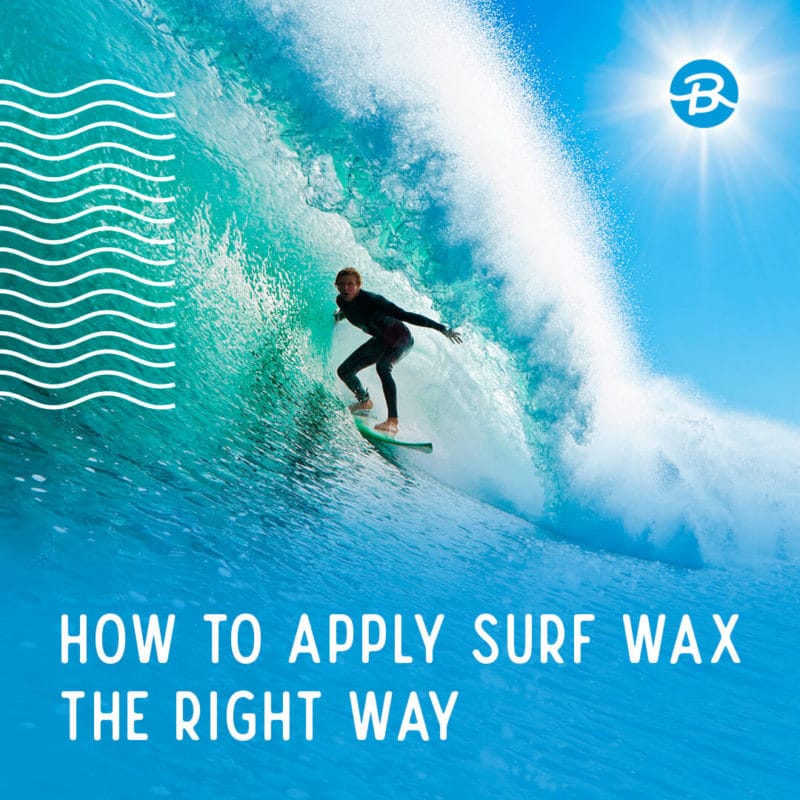Are you looking to take up skimboarding (or maybe you already have) and you’re interested in buying a new skimboard? If so, you’re in the right place! We’re going to share a complete skimboard buying guide with everything you need to know before your purchase. From the various features of a skimboard and materials to what boards work best for different types of skimming, we’ve got it all!

We’re also going to share the best skimboard brands and answer common questions so that you can choose the right skimboard for you. Let’s get to it!
Skimboard Construction
When you’re shopping for the perfect skimboard, you’ll find wooden and foam boards mostly. Wood and foam are the primary materials found in skimboards. The board’s material will reflect its flexibility, weight, and size.
A foam skimboard, also referred to as a foamie, is typically more pricey than a wooden skimboard. Their flexible, lightweight, and durable material make them better for waves than wooden ones, which are heavier and stiffer.
We’ll touch more on this later, but foamies are generally used at West Coast beaches, while wooden skimboards serve best for flatland and inland skimming.
Wooden Skimboards

These are more solid, heavier boards than their foam counterparts. Usually made from birch or mahogany plywoods, wood skimboards are for flatland skimming and small waves. This is what we refer to for those who do sand skimming or in shallow waters. They’re used more in non-coastal waters like at the lake and river.
Wood skimboards are usually more affordable than higher-end foam boards. Those who are on a budget and beginners can appreciate this. If you’re just trying to find out if skimboarding is for you, you may feel more comfortable not forking out a lot of money and starting off with a wooden board.
Because of their weight, wooden boards are not intended for deeper waters—the kind you find when you skimboard straight out from the beach and into the waves. Doing this with a wooden board can easily result in you losing your board to the bottom of the ocean because it’ll sink.
On the upside, wood boards are durable. However, you don’t want one that’s too thin given windy beach weather. Imagine running along the edge of the water and tossing your board down. If the board is too light and the wind catches it, there’s a good chance your board will be gone.
Foam Skimboards

Avid skimboarders usually prefer foam boards. Foamies usually cost more, but they’re much easier to handle and use, especially when hitting the waves. This is because their material is flexible, floats well, and is lightweight. These boards are great for boarders of all ages.
While foam skimboards are often the most preferred, especially for skilled beach skimboarders, there are some downsides. Usually, foamies cost more than wooden boards. They’re also more likely to break after a good bit of use or if not handled with care.
In summary:
Foam boards are lightweight, flexible, pricey, and great for wave riding. Meanwhile, wood boards are heavier, sink more easily, best for non-coastal waters and sand skimming, and more affordable.
Carbon Fiber Skimboard
While wooden and foam core boards are the most popular, the skimboarding world has more recently turned to carbon fiber for construction materials. Carbon fiber is light and robust, which means its strength-to-weight ratio is high. As a result, these skimboards are lightweight without being flimsy or insubstantial.
These boards are generally for the more serious skimboarders and are ideal for wave skimboarding, although if you’re doing flatland skimming, a carbon fiber board will serve you well. The trade-off, as you can imagine, is the cost.
These boards can get a little pricey, so they aren’t usually the first choice for beginners as foam core boards are.
Skimboard Wraps
No matter what the core of your board is, skimboards have a wrap. The wrap is where you see the intricate colors and patterns you may want for your board.

Wraps aren’t just for looks, though. They protect the core from water damage and can also contribute to a board’s durability. Most wraps are carbon, E-glass, or S-glass, and each has its advantages.
Carbon
Chosen by many skimboarders as the best wrap, carbon is also the most expensive option. This is why you find it most often on more pricey boards. Just like the carbon fiber used for some boards, carbon wrap is exceptionally durable. While we wouldn’t go so far as to say it’s impervious to damage, it comes pretty close.
E-glass
E-glass, a type of fiberglass, is the most common wrap by far. While it’s flexible, it’s not always as strong or durable as other wraps. With that said, it’s more prone to damage from rocks or other beach detritus you will almost always encounter.
S-glass
S-glass is a stronger and more durable version of e-glass, so it does cost more. However, it may be an investment you want to make since it’s less prone to damage. As it’s a bit stiffer than E-glass, S-glass wraps make for faster speeds as you ride waves.
Skimboard Shape
If you can picture surfboards scaled-down, you can imagine the shape of a skimboard. While surfboards typically have fins, skimboards don’t. Otherwise, their shapes are similar.
The absence of fins on a skimboard means learning to control the board. This can be more complicated than learning the same on a surfboard. Fins also add stability, so riding a skimboard will not feel as steady or secure as on a surfboard. Let’s take a look at what defines a skimboard’s shape.
Tails
The main tail shape types for a skimboard are: pintail, swallowtail, and square tail. The pintail is more common on less expensive boards. However, that’s not to say that a pintail is a beginner board.
- Pintail: This is also referred to as twin-tip because the nose and tail both come to a point. The front point and the pintail are not entirely symmetrical because it would be tough to tell which end was the front if they were. A pintail board is perfect if you like to perform tricks because it offers excellent balancing. When you ride a twin-tip or a pintail, you can ride it like a skateboard which is why skaters who start skimboarding like these.
- Square tail: As their name suggests, these tails are flat like the side of a square. They offer the rider a bit more agility and maneuverability by giving the water two places to flow from the back of the board as you skim on the water—each point of the flat, squared-off end. This gives the rider better access to sharp turns and quick-turn ability lends itself to challenging tricks and cool moves.
- Shallowtail: Faster than a pintail but slower than a square, the swallowtail offers maneuverability and often comes on a wider board. The wider your board, the less agile it will be on the water. So the swallowtail—basically a wedge cut out of the back of the board—counteracts that and gives the rider access to quick moves.
Rocker
When surfers talk about the rocker of their boards, they’re talking about the curve along the length of the board. The steeper the nose rocker, the more the tip of the board curves upward. The same goes for skimboards which have either a steep or shallow rocker.
With a steep rocker, you’ve got a little breathing room when it comes to choppier waters and larger waves. However, these rockers can slow the board down. However, with a nose that sits higher up, the board is less likely to sink under the water when you skim out toward the waves.
A shallow rocker means the nose of your board sits lower. This makes for a faster ride but is much less suited for bigger waves. Skimboards with shallow rockers are best for flatland skimming, as you’re dealing with hardly any waves at all.
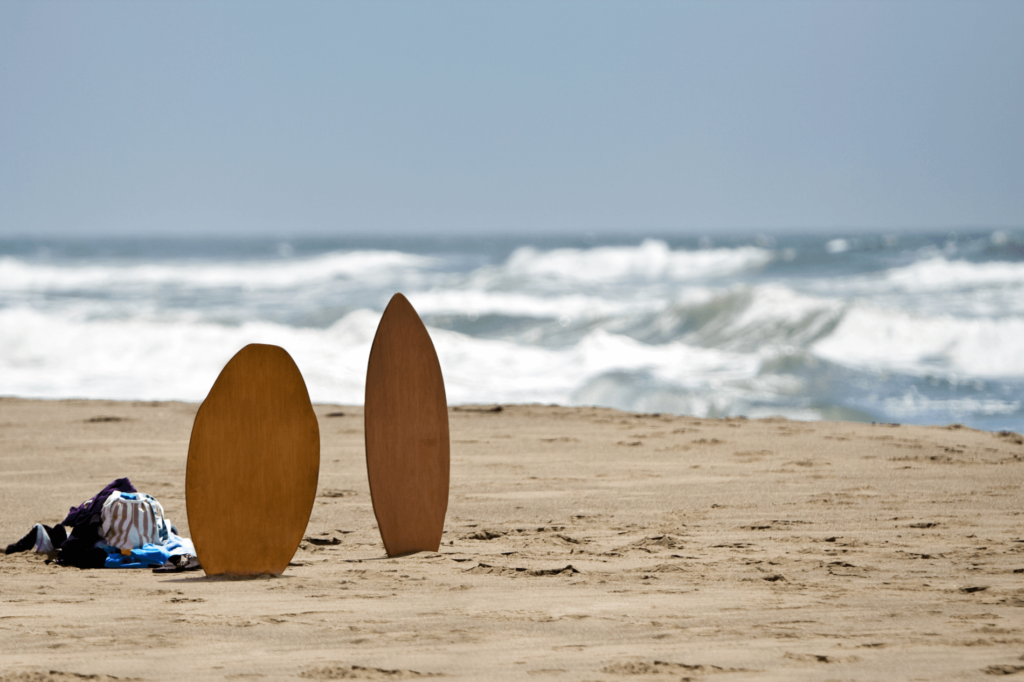
Skimboard Sizes
The size skimboard you choose will depend on what kind of skimming you’ll be doing. It also depends on your own height and weight.
Consider your skills.
In short, a smaller board is best for skilled skimboarders while larger boards are best for beginners.
The perfect skimboard for you will depend on your skills and what kind of skimboarding you’ll be doing. To skimboard well, you’ll need speed. The faster you can go, the farther you can ride. And the faster your board goes, the more buoyant it becomes. Increased buoyancy makes skimming easier.
Speed comes from the board’s weight and its ability to float. A bigger board can float more easily, but it’s also much less maneuverable. Skimboard veterans prefer smaller boards because they allow for quicker turns and more technical tricks. So, you can decide on the board for you based on these factors.
If you’re a new skimboarder, you’ll want to consider that it’s easier to lose control of a bigger board. But, you don’t want a skimboard that’s too small because then it can be difficult to stay up.
Consider your size.
The size of your board and surface area will depend on the size of your body. Skimboard manufacturers have their own skimboard size charts for you to check. However, a general rule of thumb is to go along with your clothing size. If you wear a small t-shirt, a small size skimboard might be best for you, and if you wear an XL, then an XL size skimboard will be best for you.
You can use your height to determine your skimboard’s length, too. The best skimboard length will be one that can stand next to you, and its tip at least reaches your chest and doesn’t come up higher than your chin. This tip comes from Zap Skimboard brand, which also provides a sizing chart here.
Types of Skimboarding
Now that we’ve covered skimboard materials and shape, let’s take a look at types of boarding. If you’re a newbie, this may help you understand further how to pick the best skimboard for you. Types of skimboards will be chosen based on where you live and what kinds of waters you’ll be boarding on.
Flatland Skimming
Perhaps the oldest form of skimboarding, flatland skimming, started with bored lifeguards. They were looking for something to do and began tossing boards onto the wet sand or very shallow water at the edge of the ocean.
You can do flatland skimming at any body of water. Whether you’re at a beach or lake, grab your skimboard and toss it down at the edge of the water. Jump on it and skim along the very shallow water.
Inland Skimming
Inland skimboarding is basically the same thing as flatland skimming, except it’s done on a marsh or even a large puddle. For inland skimming, you’ll need shallow water and your board. You can even do it with a big puddle in your yard!
Wave Skimming
We most often see wave skimming like in this video of World Champion Skimboard Austin Keen. As you can imagine, this involved skimming out into the ocean on waves rather than skimming along the edge of the water.
Wave skimming also involves making a quick turn and riding the wave back to the shore. In order to properly do this, you need a responsive board that allows for maneuverability. Because of that, we recommend smaller boards over wide boards. And, going back to the rocker, you’ll want a steeper one to keep the nose of the skimboard from dipping under the water as the waves come toward you.
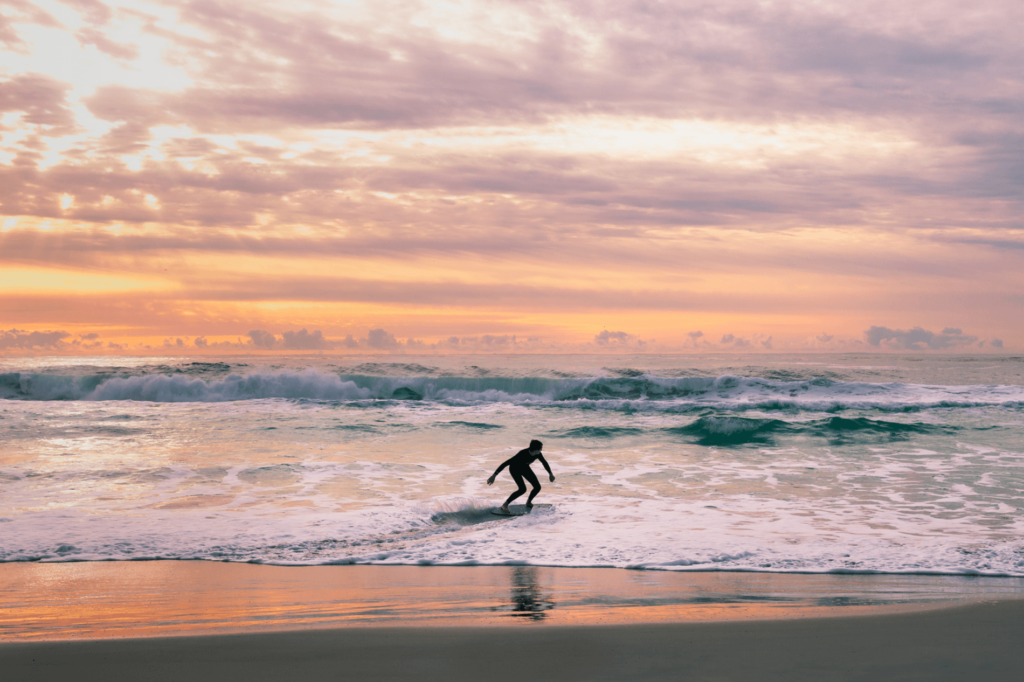
Where You Skimboard Matters
Due to the direction of winds and the way the wind direction pushes the ocean water to the west, waves on the east coast are typically smaller so where you skim will play a role in the best skimboard for you.
The East Coast
If you’re skimming on the east coast, you’ll probably be dealing with smaller, less powerful waves. With that said, you’ll probably want a heavier, larger board. The heavier the board, the more you’ll be able to speed it up on the sand and waters. With that said, it’s best to avoid those extra light foamies even though they are more affordable.
The West Coast
It’s no coincidence that the USA Surfing’s competition schedule shows more west coast destinations than the east coast. While the east coast has incredible beaches, the waves are much larger across the way, and professional skimboarders much prefer that.
You’ll want a lighter board for wave riding on the West Coast since you don’t need the added weight to maintain speed. Carbon fibers and foam skimboards are great for this!
Flatland and Inland Skimming
As we mentioned, if you aren’t skimming out into the waves, then this won’t make much of a difference to you. Like with smaller waves, no waves mean you’ll want a heavier board so you can speed it up. If you have good skimming skills, you can also use a lighter board and still move it the way you want.
Skimboarding Accessories
Now that we’ve gone over all things skimboards, let’s take a look at accessories you’ll want to have. Accessories allow you to ride like a pro without slipping off with wax and grip pads, plus a carrying bag keeps your board safe.
Wax
Plain old surf wax works excellent for skimboards as the principle is the same. You simply want to make a sticky surface for your feet to grab on to while you ride. This allows you to stay up without slipping around.
There’s not really a designated wax specifically for skimboards. Surfboard waxes like Sticky Bumps or Sex Wax are great to use on your skimboard. Be sure that you purchase a wax that’s appropriate for the water temperatures you’ll be in.
Steps and tips for waxing your skimboard:
- Clean your skimboard entirely.
- Apply a base coat of wax that’s not too thick in small circles on the top of your board.
- Gently apply your topcoat using another pattern while creating small bumps that are good for gripping.
- Apply a top coat each time you skim. Clean your board and start the process over at least between every skimming season.
Check out this complete guide for waxing your skimboard.
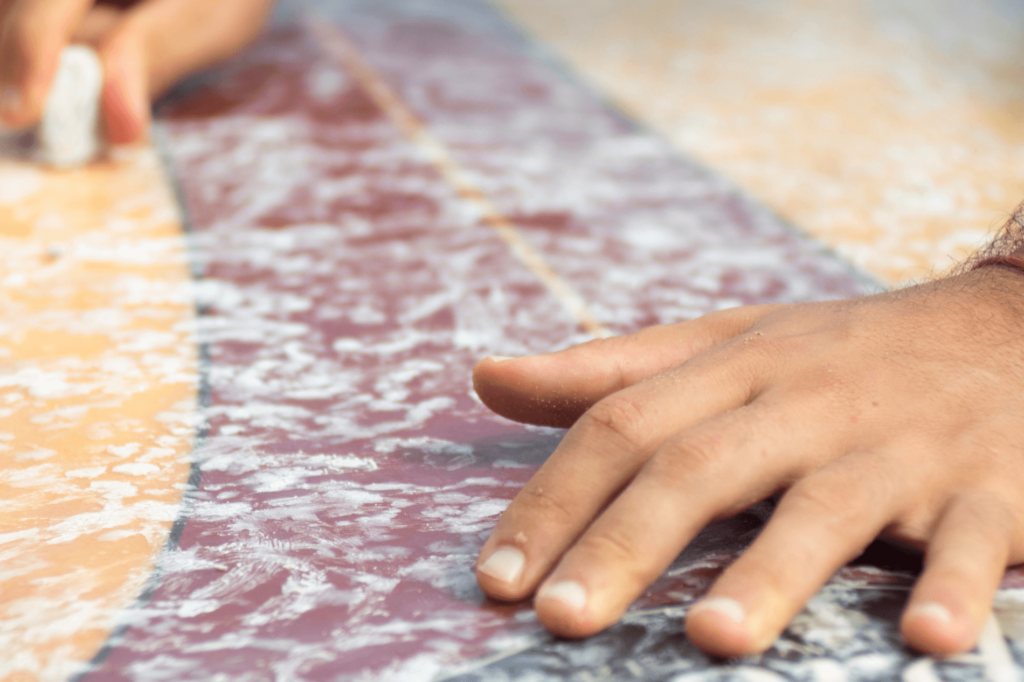
Traction Pads
Similar to the wax, the traction or grip pads keep your feet from slipping. The advantage that pads have over wax is that you can tell without looking whether your feet have found the right spots on the board since the traction pads go where your feet should be.
Traction pads come in many configurations. A popular brand is Zap Skimboards, which offers the Zap Vader pads, a front pad traction and a back pad traction.
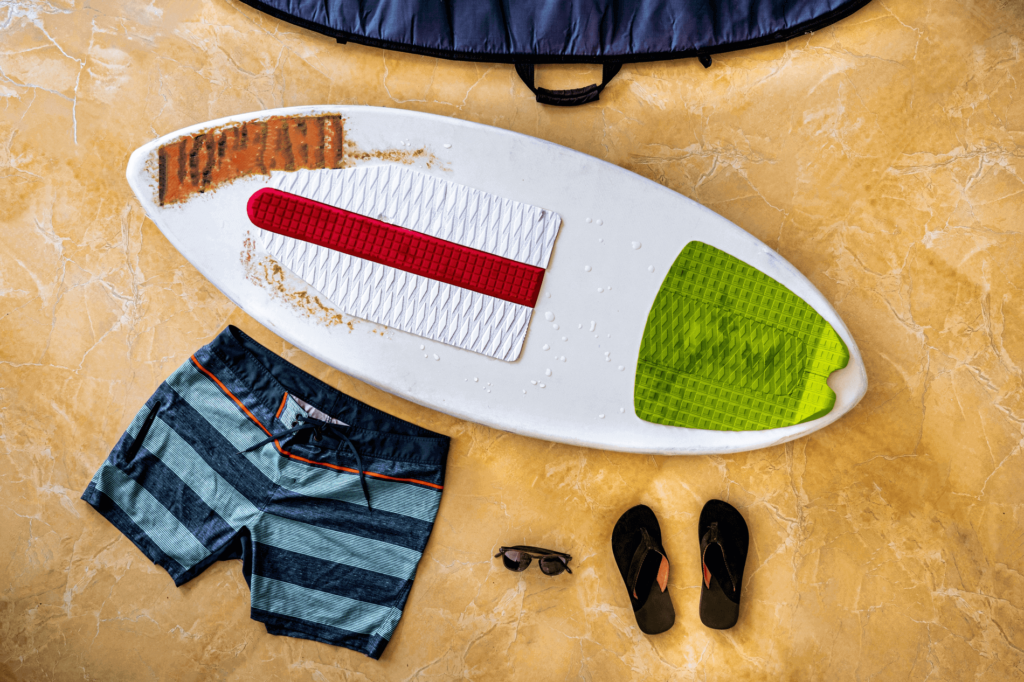
Arch Pads
Arch pads provide traction and foot guidance for those who want to find the center of the board every time. The arch pad is a raised, ridged pad that runs down the middle of the board. If you’ve got really flat feet, this won’t be the most comfortable thing to stand on so you may want to test some out to find your best fit.
Not sure where to start for arch pads? Check out Wavezone Skimboard’s wide selection of arch bars.
Skimboard Bags
While skimboard bags aren’t required, you probably want to invest in one. They’ll keep your board protected, allowing it to last longer. Bags are ideal for storing and carrying your board from place to place while keeping it safe from dings and scratches. Keep reading to learn what the best bags are!
Skimboard Buying Guide
Now that you have all the information about skimboards and their features, let’s check out specific options so that you can find the right board for you! We’ve narrowed down the best skimboard brands for various abilities, styles, and price points.
Best All-Around Skimboard: Slapfish 48” Fiberglass & Carbon Skimboard
The Slapfish 48″ Fiberglass & Carbon Skimboard offers the best of both worlds. Its foam core has carbon reinforcement at the front and back for assured durability. While these aren’t the most affordable boards, it’s a high-quality product that’s sure to serve you well.
This fiberglass skimboard has a polished deck and ultra-glide bottom. It has a professionally installed traction pad and includes an option arch bar. It’s ideal for sand sliding and wave riding. It’s lightweight, easy to maneuver, and it looks great!
Best Wood Skimboard: BPS Gator Skimboard
With a weight limit of 130 pounds, the BPS Gator Skimboard isn’t for everyone. It has a built-in traction pad and perfect grip even when wet, so wax isn’t needed for this one. Although it’s a wood board, it’s light compared to others and is easy to carry around.
Although any board can get damaged with enough use and exposure, the high-gloss epoxy wrap gives the board extra protection. Its nose is a bit more rounded than most boards, which should give you a little more control, especially if you’re new to the sport.
As we mentioned earlier, wood boards are often the choice for newer skimboarders, so you may not like this one if you have a higher skill level. With that said, it’s perfect for beginners and casual riders.
Best for Riding Waves: Zap Fish Skimboard
Are you looking to hit the waves and do some tricks? If so, the Zap Fish Skimboard might be the way to go. This skimboard is best for someone of average size and skill level.
The Zap Fish Skimboard has some extra float and surface area to help speed up the process of riding waves and performing tricks. Its wide nose and belly create a stable platform to help you keep your balance on the water, and its fish tail helps with agility and speed.
Best Budget Skimboard: Driftsun Performance Wood Skimboard
If you’re looking for something simple, the Driftsun Performance Wood Skimboard might be ideal for you. This wood skimboard is great for what it is. It’s an inexpensive option that offers two different sizes to accommodate different riders, and it comes with a built-in grip pad.
This skimboard is lightweight, so it’ll go with you as you advance in your skimming ability. You’ll be able to perform tricks on it that can be more challenging if you’re trying to do them on a heavier board.
Frequently Asked Questions
As you make the big decision on the right board for you, you may have a few more questions. That’s why we’ve answered the most common skimboard questions below!

What are the best skimboard brands?
As we mentioned above, the three best boards we’ve found for all-around purpose, wood material, and budget are Slapfish, BPS, and Driftsun. While your skill level, skimboard cost, and several other factors will play a role in what you purchase, pro skimboarders most often recommend these skimboard brands:
- ZAP Skimboards
- Victoria Skimboards
- Wave Zone Skimboards
- DB Skimboards
- Fedmax Skimboard
- Slapfish Skimboards
- Driftsun Skimboards
- BPS Skimboard
What are the best skimboard bags?
When looking at bags, you want to consider size, durability, and straps (backpack style, shoulder, or handle style). Here are some of the best skimboard carry bags:
- Slapfish Skimboards Carry Bag: fully padded, adjustable strap, durable zipper
- Wave Zone Padded Bag: backpack or shoulder strap style, fully padded
- DB Wanderer Skimboard Travel Bag: holds up to 5 boards, durable, multiple strap styles
How difficult is skimboarding?
People often equate skimboarding with surfing or skateboarding. It helps to be in relatively good physical shape for all three activities. Flexibility and a good sense of balance come in handy, too. Skimboarding should be fairly easy to pick up if you meet these criteria.
If we had to rate these three sports in descending order of difficulty, surfing would be at the top of the list for most challenging, then skateboarding, and skimboarding being the least difficult. Some people may argue about the order of the last two, but it’s safe to say that surfing is the most challenging.
With all of that said, skimboarding is an extremely fun activity and totally doable for most people who put in the effort. To see how it’s done, check out this video with 3x World Champion Blair Conklin.
Is skimboarding like surfing?
Yes and no. For both activities, you’re popping up on a board. But, the way you do it is different. Also, surfers must hit the ocean, while skimboarders don’t have to. Surfing is also known to be more challenging. Check out the next question for more on this.
How do you skimboard for beginners?
The surfing similarities continue. If you know about surfing, you know that once you’ve paddled for and caught your wave, you pop up. Spring to your feet and land them simultaneously on the board. Skimming requires the exact simultaneity, only without getting there from a prone position.
Getting on skimboard looks like this:
- At the water’s edge, you hold your board to your side with your dominant hand toward the back.
- Take off running along the water.
- Once you’ve got some speed, toss the board down on the water without slowing down.
- Hop on the board. Both feet have to land at the same time. Otherwise, you will fall.
- If you land with your back foot first, you’ll bog the board down. It may stop its forward movement faster than you will, which means you’ll fall forward.
- If you land with your front foot first, you might stop the board or push it off to the side, which again results in you splashing down into the water.
Try it several times and you’ll probably find that you’ll naturally get the hang of it!
Is skimboarding good exercise?
Sure! Skimming requires some running, so you’ll get your heart rate up while doing that. Keeping your balance also requires core strength. If you’re wave skimboarding or performing tricks on your skimboard, you’ll use even more strength. In turn, skimboarding will make your core stronger and improve your cardiovascular health.
While one skimboard ride won’t get you in shape, the more you do it, the better. For those who take up skimboarding as a regular activity, it’s excellent (and fun) exercise.
Is skimboarding dangerous?
Like any sport, skimboarding can have an element of danger. If you know what you’re doing and you’re careful, you probably won’t ever face serious risk.
Keep in mind that the ocean naturally brings potentially harmful situations no matter what you’re doing. Being aware of these possible occurrences can help you stay safe.
Flatland skimming is usually the safest as you aren’t in anything more than ankle-deep water. Of course, your skill level will matter. As you get better with skimboarding, you can feel better about what you’re doing and understand conditions more.
Is a skimboard the same as a bodyboard?
No, skimboard and bodyboards aren’t interchangeable. Sure, you can try skimboarding on a bodyboard, but we don’t recommend it. Bodyboards are wider and a little more squared-off than skimboards, while skimboards are thinner. With that said, they each serve their own purpose.
When you ride a skimboard, you stand on it. Meanwhile, bodyboards are designed for us to lie down on them and occasionally rise to one knee. You probably shouldn’t try standing on a bodyboard as you would a skimboard.
The way you use each board is different, too. When you ride a wave on a bodyboard, you get to the wave by paddling out to it, then turning around and paddling to catch the wave. On a skimboard, if waves are involved, it’s only after you’ve gotten a running start and hopped on the board before you skim out to the oncoming wave.
Where are the best skimboarding beaches?
If you’re planning your next skimming beach trip in the US, you might be wondering where you should go. There are many awesome beaches to go skimboarding. As we mentioned, the west coast has bigger waves if that’s what you’re interested in. Here are some of our top recommendations for best skimboarding beaches:
- Aliso Beach Park, Laguna Beach, CA: popular spot for pro skimmers
- Madaket Beach, Nantucket, MA: hidden gem that offers some peace and quiet for skimmers
- Fort Lauderdale Beach, Fort Lauderdale, FL: impeccable, long beach lined with palm trees
- Pounders Beach, Oahu, HI: fun, young crowd and lots of shore breaks
Final Thoughts
Skimboarding is an exciting activity you can do at the beach, the lake, or anywhere there’s even a little water! Several factors go into choosing the best skimboard, but knowing what you’re looking for can help take the guesswork out of it for you.
Doing some research is essential so you don’t go into your new purchase blindly. When buying your skimboard, be mindful of the following: your skill level, where you want to skimboard, what the waves are like if you’re doing wave skimboarding, what size board you’ll need, what your budget is, and what accessories you need.
We hope this skimboard buying guide has you feeling confident and excited. And most importantly, enjoy your skimming adventures!
